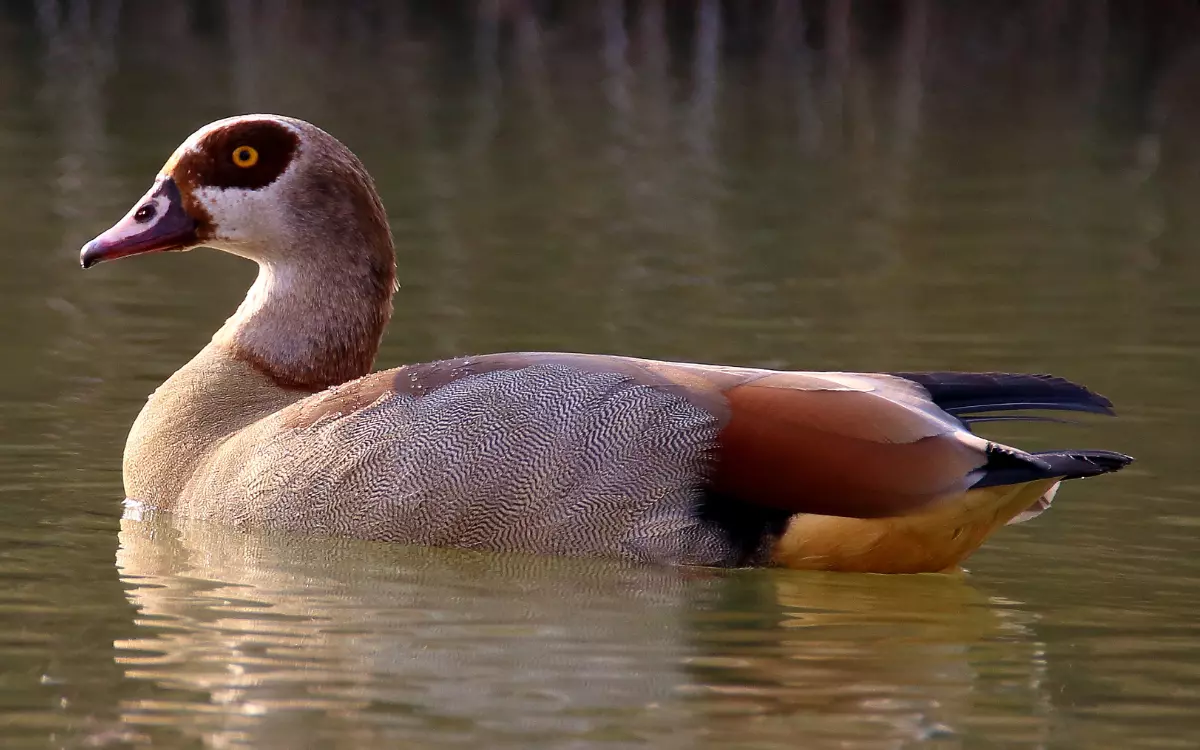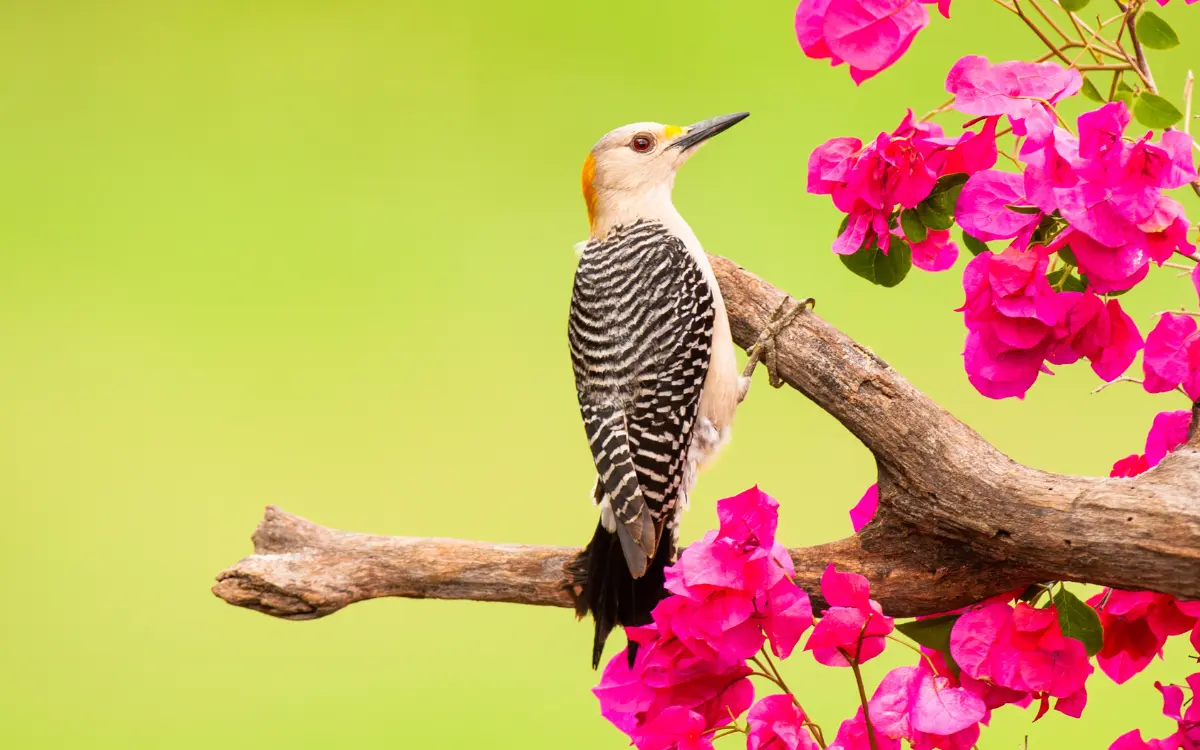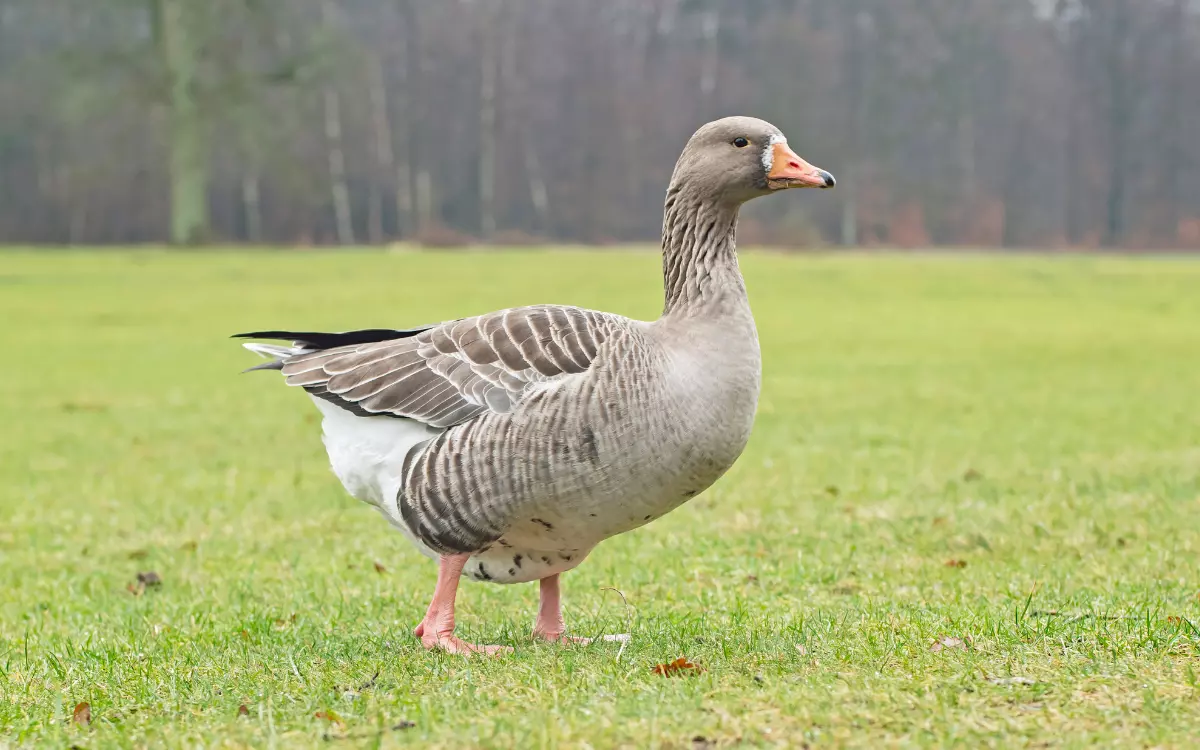16 Black Birds In South Carolina
Discover the world of black birds in South Carolina! These stunning creatures, from sleek crows to charming starlings, play a vital role in our local environment. Let’s explore their fascinating lives together!
List 16 Black Birds In South Carolina
1. Brown headed Cowbird
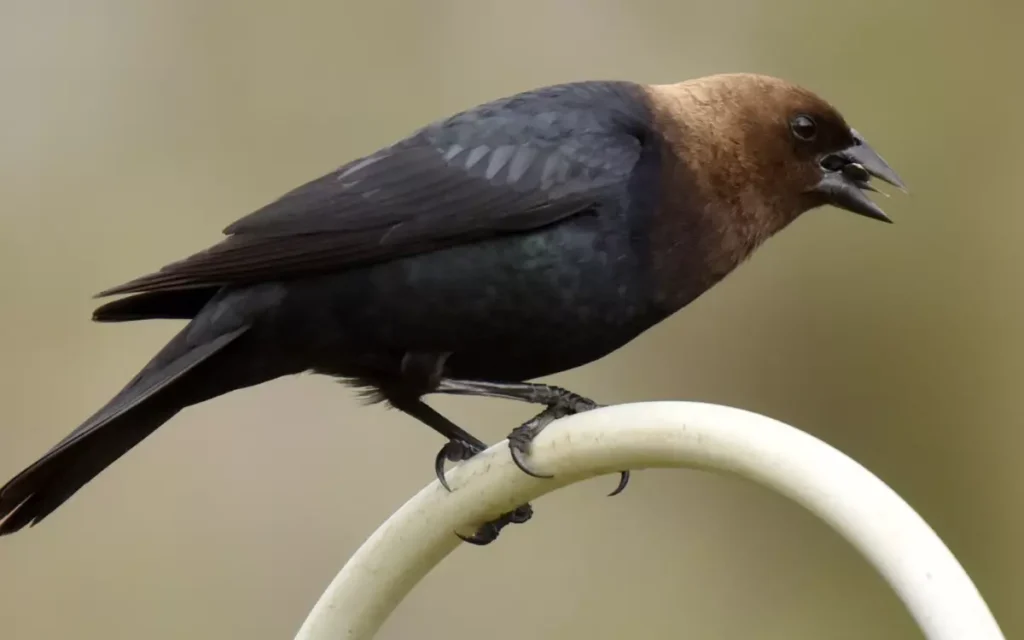
The Brown-headed Cowbird, with its distinct brown head and black body (for males), is a unique bird native to North America.
It’s known for its unusual nesting habit of laying eggs in the nests of other bird species.
- Size: They measure about 7.5 inches in length.
- Nesting: Cowbirds do not build their own nests; instead, they practice brood parasitism.
- Habitat: Commonly found in open or semi-open areas, especially near fields or livestock.
To attract these blackbirds to your backyard, consider providing a mix of seeds and grains in your bird feeders.
They are particularly fond of millet and sunflower seeds. Additionally, maintaining a patch of open grassland or a meadow-like area in your yard can create an inviting environment for them.
Remember, these birds are ground feeders, so low feeders or scattering seeds on the ground can also encourage their visit.
2. Red-winged Blackbird
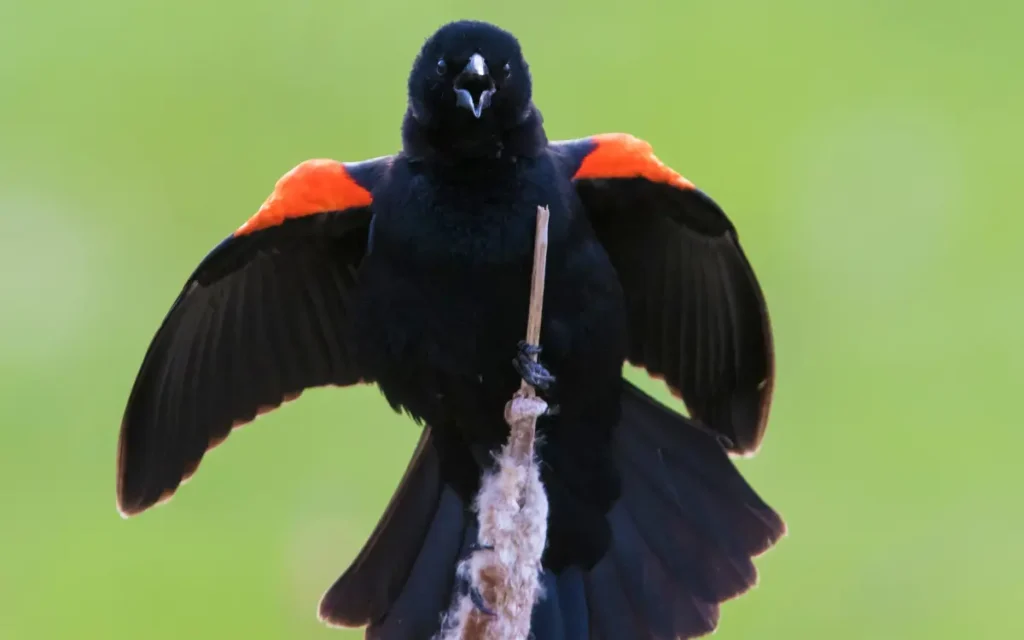
The Red-winged Blackbird is a striking bird, known for the males’ vivid red shoulder patches contrasting with their black plumage. They are a common sight in wetlands and marshes across North America.
- Size: Typically about 7-9 inches in length.
- Nesting: They prefer nesting in dense reeds or bushes, usually near water bodies.
- Habitat: Easily spotted in marshes, along water edges, and in wet grasslands.
Attracting Red-winged Blackbirds to your backyard involves creating a bird-friendly habitat. Include a water source like a birdbath or a small pond, as they are attracted to water.
Planting tall grasses or bushes can provide them with a sense of security and a natural environment. For food, they enjoy a variety of seeds, particularly sunflower seeds, and can be often seen at bird feeders that offer these.
3. Boat-tailed Grackle
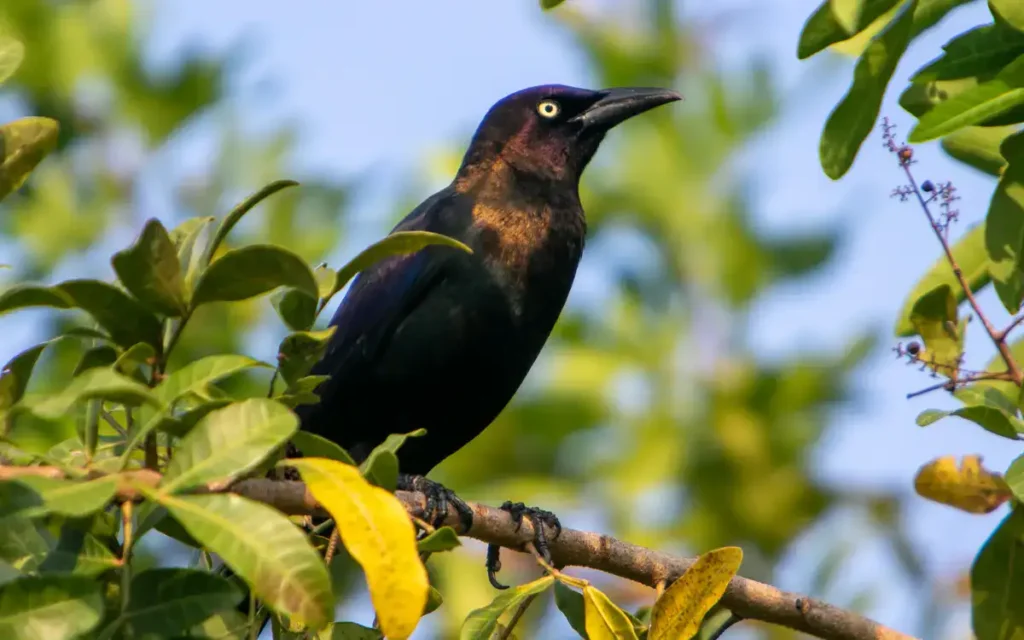
The Boat-tailed Grackle is a notable bird species found mainly along the Gulf Coast and in Florida near saltwater. It’s easily identified by its long tail and glossy black appearance in males, while females are smaller and brown in color.
- Size: The Boat-tailed Grackle measures about 10.2-14.6 inches in length, with a wingspan ranging from 15.3-19.7 inches.
- Nesting: These birds nest in cattails and other grasses of freshwater or brackish marshes, typically around 2 feet off the ground. They may also nest in isolated trees or bushes near water.
- Habitat: You can commonly find them in marsh edges, beaches, parks, or towns, often looking for discarded food.
To attract Boat-tailed Grackles to your backyard, consider using sunflower seeds, millet, or corn in platform feeders.
They are also known for their unique mating system, where high-ranked males defend clusters of nesting females from other males.
4. European Starling
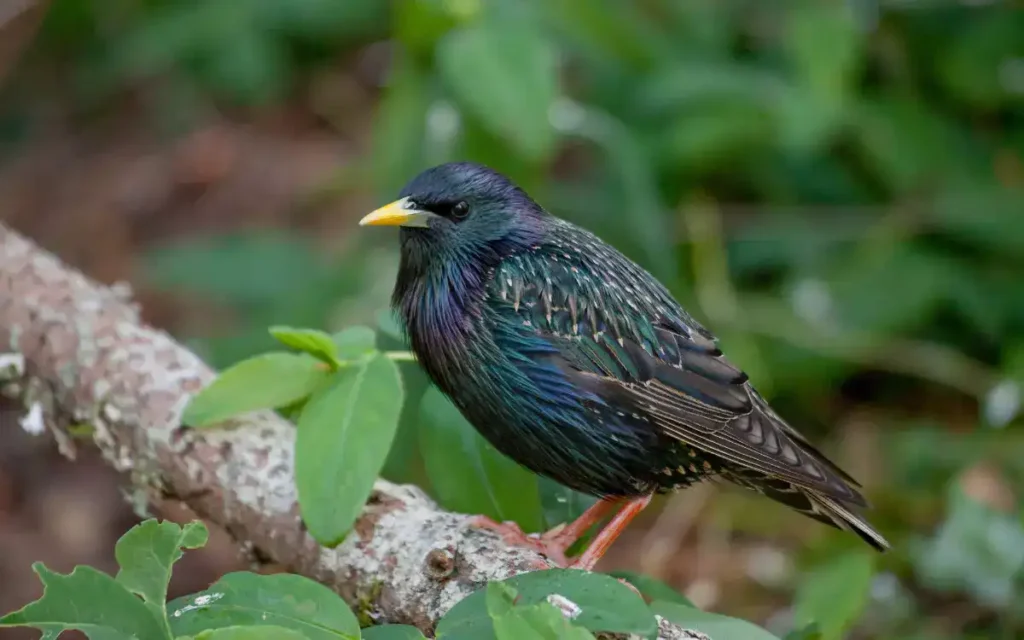
The European Starling is a medium-sized, adaptable, and tough bird, known for its adaptability and presence in a variety of habitats. Originating from Europe, it was introduced to North America and has since become widespread.
- Size: European Starlings measure about 8-9 inches in length, with a wingspan ranging from 12-17 inches.
- Nesting: Starlings typically nest in cavities, often found in buildings, other structures, old woodpecker holes, or nest boxes. Males choose the nest site and start building the nest before mating. The nest is usually placed 10-25 feet off the ground but can be as high as 60 feet.
- Habitat: They are most numerous in farm country and in suburbs and cities, but can adapt to almost any disturbed habitat. They avoid large, unbroken stretches of forest, chaparral, and desert.
To attract European Starlings to your backyard, providing a variety of food such as insects, fruits, suet, and seeds can be effective.
They are particularly fond of suet and cracked corn. Providing nest boxes can also encourage them to visit and stay in your area.
Related article:
5. Baltimore Oriole
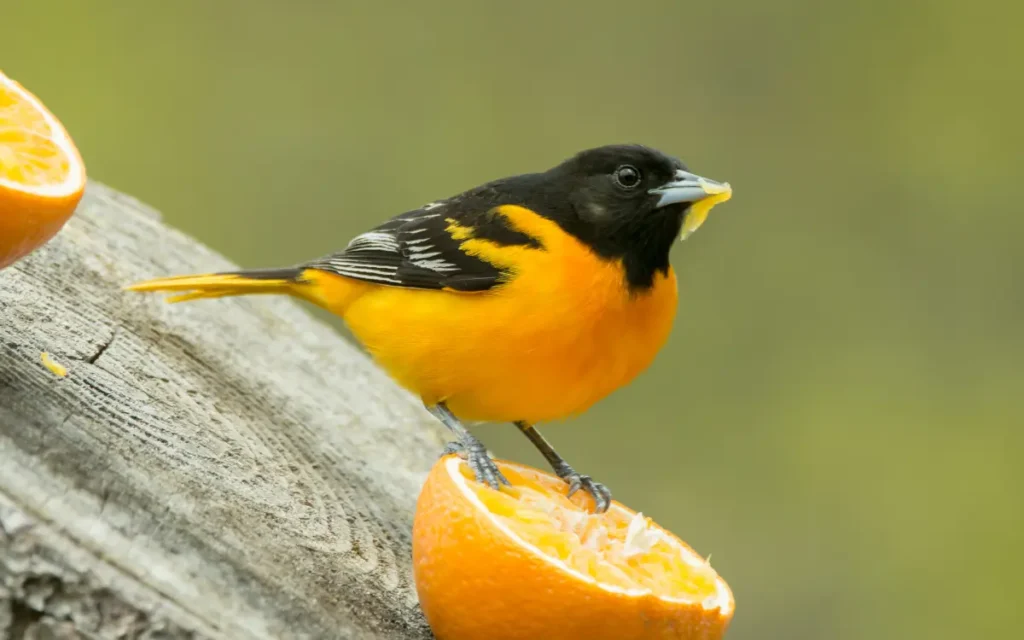
The Baltimore Oriole is a vibrant and colorful bird commonly found east of the Rocky Mountains in both Canada and the USA.
They are known for their striking orange and black plumage, with the male showcasing a bright orange underpart and a black head, while females typically display a mix of orange, browns, and yellows.
- Size: Baltimore Orioles are medium-sized birds, with males characterized by a black head, bright orange underparts, and black wings with white streaks. Females tend to have a gray head, yellow-orange underparts, and gray wings with white streaks.
- Nesting: These birds typically nest in deciduous trees and tall mature shrubs within open woodlands or forest fringes, usually avoiding deep forests. They construct their nests on the narrow shafts of long, drooping branches, often in trees like oaks, maples, elms, sycamores, and fruit trees such as apples and cherries.
- Habitat: You can spot Baltimore Orioles perched at the tops of trees or flitting through the upper foliage in search of insects. They are most often seen in open deciduous forests, riverbanks, and forest edges, and have adapted well to human settlement, being found in parks, orchards, and backyards.
To attract Baltimore Orioles to your backyard, there are several effective strategies:
- Offer ripe, dark-colored fruits such as oranges and dark berries. Orioles are particularly drawn to the color orange, so hanging orange halves from trees can be very effective.
- Provide nectar feeders designed for orioles, filled with sugar water. Avoid using food coloring in the sugar-water mix.
- Grape jelly is another favorite of these birds. Offering a small amount in a dish or feeder can lure them to your yard.
- Incorporate native trees in your garden, such as Tulip Poplars, Autumn Blaze Red Maples, and Sugar Maples, which offer excellent nesting locations and food sources.
- Ensure the availability of water by including a birdbath in your backyard.
6. Rusty Blackbird
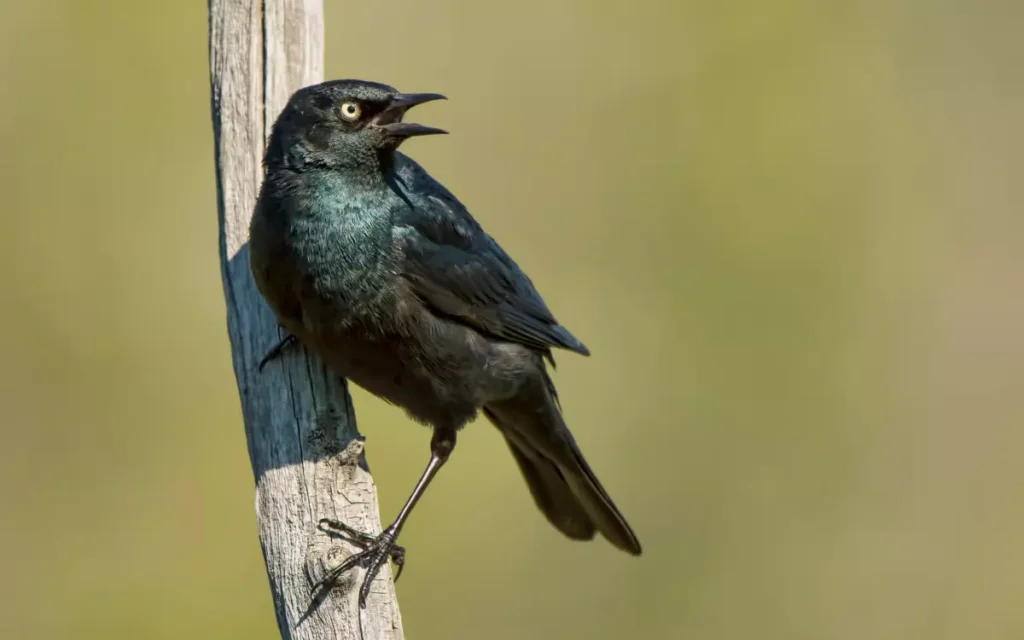
The Rusty Blackbird is a medium-sized bird native to North America, known for its rapid population decline over recent years.
This species is distinctive for its pointed bill, pale yellow eyes, and plumage that changes seasonally.
Adult males have black plumage with a faint green and purple gloss, while females are greyer. The name ‘Rusty’ refers to their brownish winter plumage.
- Size: Rusty Blackbirds are about 8.5–9.8 inches in length, weigh around 60 g (2.1 oz), and have a wingspan of approximately 14 inches.
- Nesting: They typically nest in wet temperate coniferous forests and muskeg. The nests, usually made of twigs and grass, are often located in a tree or dense shrub, often over water. These nests are placed low, typically only a few feet above water or ground, but can be up to 20 feet high in a coniferous tree.
- Habitat: Their breeding habitat includes the muskeg region in wet northern coniferous forests with many lakes and bogs. In migration and winter, they favor areas with trees near water, like wooded swamps and riverside forests, and may also forage in open fields and cattle feedlots with other blackbirds.
Attracting Rusty Blackbirds to your backyard can be challenging due to their specific habitat preferences.
However, maintaining a bird-friendly environment with access to water and providing food sources like insects and seeds could encourage their visit.
Since they forage by walking on wet ground or wading in shallow water, creating a natural, wetland-like area in your garden might also be beneficial.
Related article: Exploring South Carolina Falcons: Photos,Call
7. Brewer’s Blackbird
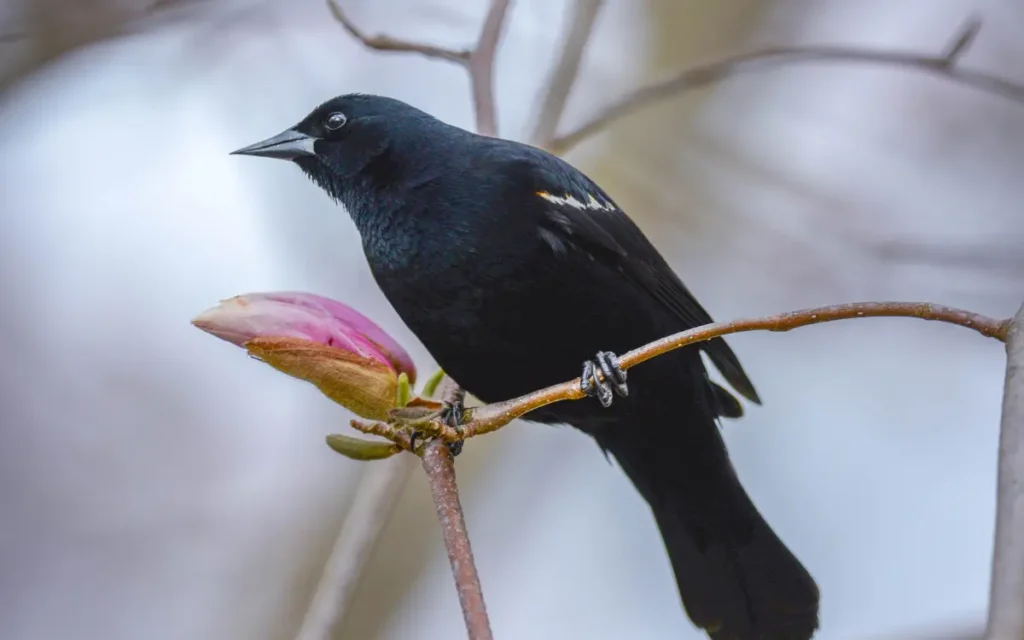
The Brewer’s Blackbird is a medium-sized bird with a distinctive appearance. The males have a glossy black coat with hints of purple on the head and a greenish iridescent color on the body. Females, on the other hand, are plain brown all over.
- Size: They range from 7.9 to 9.8 inches in length, weigh about 1.8 to 3.0 ounces, and have a wingspan of approximately 14.6 inches.
- Nesting: Their nests are made from twigs and grass, twisted together in shrubs or trees. Initially, the nest is lined with mud for stability, followed by a lining of soft dry grass.
- Habitat: Brewer’s Blackbirds can be found in a variety of habitats including grasslands, marshes, meadows, woodlands, and coastal areas. They are also quite adaptable to human environments like parks, fields, and backyards.
To attract Brewer’s Blackbirds to your backyard, you can put out seeds such as hulled sunflower seeds, cracked corn, and millet on ground feeders or platform feeders.
These birds are known to live in a variety of natural habitats as well as manmade ones, primarily in the western half of North America.
8. Western Meadowlark
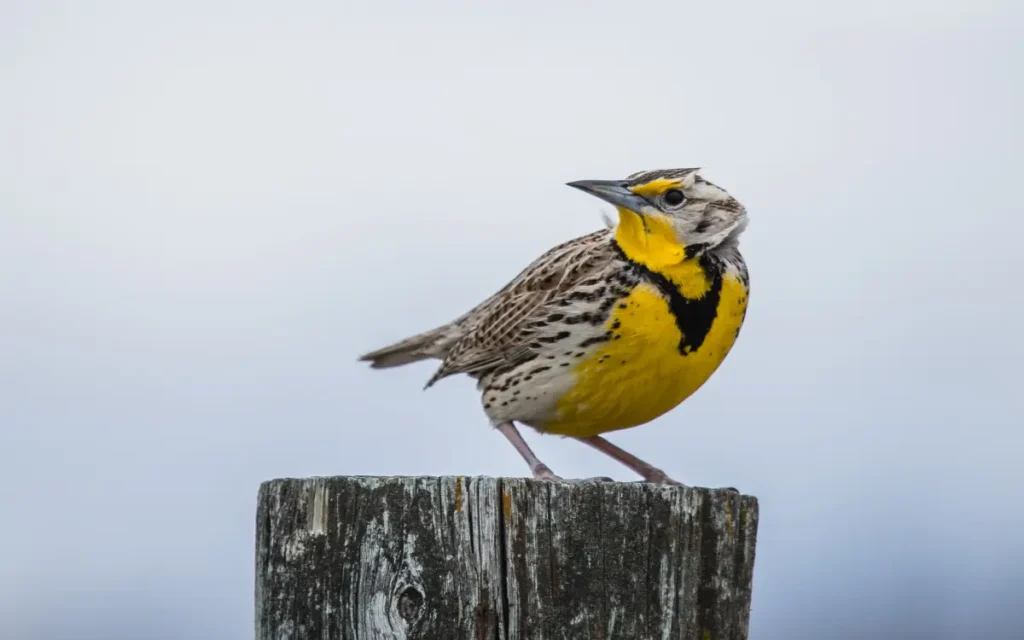
The Western Meadowlark is a charming bird known for its buoyant, flutelike melody. This colorful member of the blackbird family showcases a vibrant yellow breast crossed by a distinctive, black V-shaped band. They are commonly found in grasslands, meadows, pastures, and along marsh edges throughout the West and Midwest.
- Size: Western Meadowlarks are typically around 8 to 10 inches in length. They are stocky birds with a long slender bill and a short tail.
- Nesting: Their nests are quite unique, often partially covered by a grass roof and sometimes featuring an entrance tunnel several feet long. The nest is usually placed on the ground in areas with dense cover of grass. The female builds the domed structure with an entrance on the side, made of grass stems interwoven with the surrounding growth.
- Habitat: You can find Western Meadowlarks in open grasslands, meadows, fields with low-growing vegetation, and along marshes and road edges with sparse cover.
To attract Western Meadowlarks to your backyard, although they are not regular visitors at feeders, they occasionally visit feeding stations in open habitats.
Offering food like seeds and insects could entice them.
They forage by walking on the ground, often probing the soil with their bill, so providing a natural, grassy environment could also be beneficial.
Related article: 6 Species Hawks of South Carolina to explore
9. Bullock’s Oriole
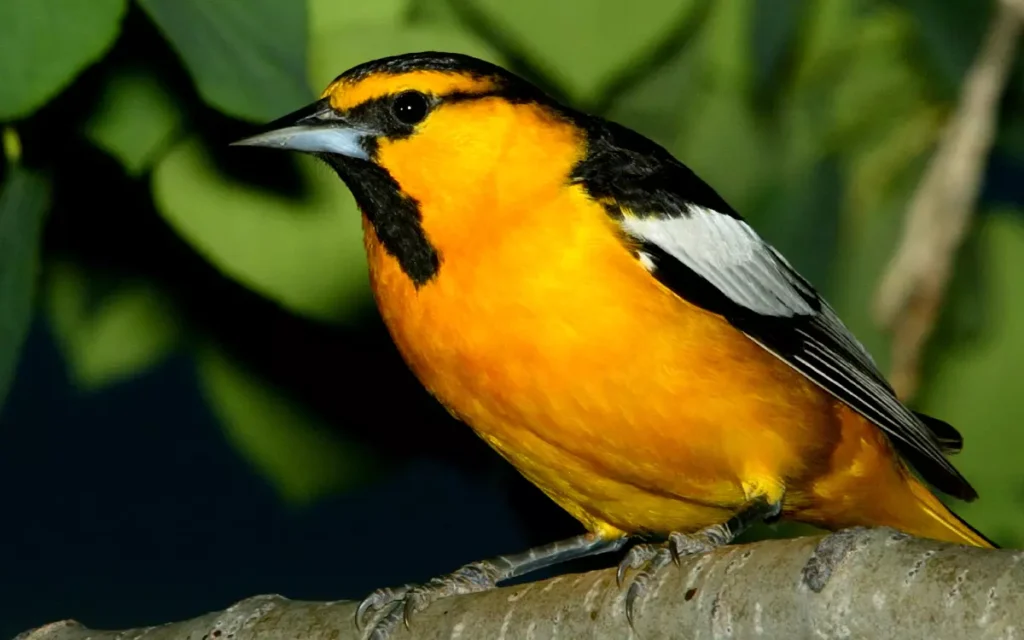
The Bullock’s Oriole, a vibrant and colorful bird, is commonly found in open woodlands across the western United States. These birds are particularly known for their distinctive orange and black plumage in males, and grayish-orange coloration in females.
- Size: Bullock’s Orioles typically measure between 7 to 8 1/2 inches in length. They have a notable orange face with a black eyeline and a large white wing patch in males, while females have a yellowish head and breast with a whitish belly.
- Nesting: These birds build unique hanging nests, woven from plant fibers, grasses, and sometimes string. Nests are usually placed high in trees, often in cottonwoods, and can be up to 60 feet above ground. The female primarily builds the nest, with occasional assistance from the male.
- Habitat: You’ll find them in summer in forest edges, farmyards, leafy suburbs, and particularly along streams in cottonwood trees. They are also common in riparian woodlands and adapt well to suburban neighborhoods with sufficient trees.
Attracting Bullock’s Orioles to your backyard can be a rewarding experience. These birds are attracted to sugary foods, especially during their spring migration.
You can offer them a mixture of water and grape jelly, blended into a syrupy nectar, in a small, shallow container.
They may also visit hummingbird feeders with perches. Additionally, hanging orange halves in your backyard or setting out fruit feeders can lure these orioles. Transitioning from sweets to mealworms once they start nesting can also be effective.
10. Shiny Cowbird

The Shiny Cowbird is an interesting species with distinct characteristics and behaviors. It’s native to South America and has expanded its range to the Caribbean and southern Florida in recent times.
- Size: The size of Shiny Cowbirds varies among subspecies. They generally weigh between 31-65 grams and measure 18-22 cm in length.
- Nesting: Shiny Cowbirds are brood parasites, meaning they do not raise their own young but lay their eggs in the nests of other bird species. They use a variety of hosts, and their eggs have a short incubation period of about 10–11 days.
- Habitat: They prefer open areas such as open forests and cultivated land. In the U.S., they are still uncommon, mostly found in southern Florida. Their range expansion is partly due to deforestation and conversion of forests into agricultural land.
Attracting Shiny Cowbirds to your backyard might not be straightforward due to their parasitic nesting behavior.
However, maintaining a natural habitat with a variety of bird species could potentially attract them. This could include having areas that mimic their natural habitat, like open spaces with trees and shrubs.
11. Scott’s Oriole
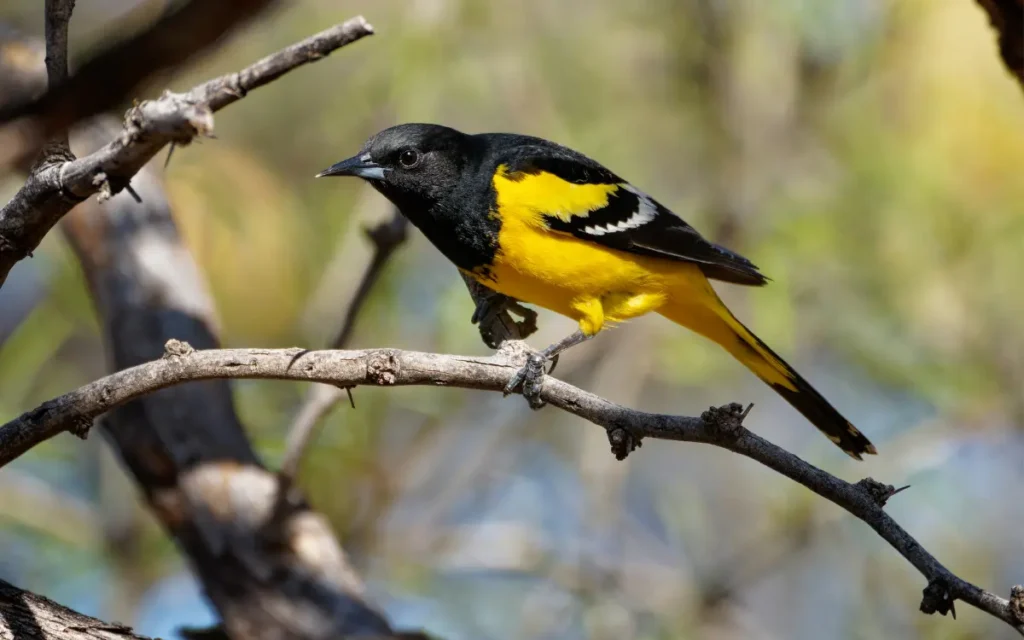
The Scott’s Oriole is a visually striking bird found primarily in the arid Southwest of the United States. It’s known for its rich lemon-and-black plumage in males and is often associated with yuccas, where it forages for insects and nectar and uses yucca fibers for its nests.
- Size: Scott’s Orioles typically measure about 9 inches in length.
- Nesting: These birds often nest in yuccas or Joshua trees, using the long fibers of these plants in their nest construction. The nests are usually placed 4-20 feet above the ground and are often hidden in clumps of mistletoe when in trees.
- Habitat: They inhabit semi-arid zones of the Southwest, including oak zones of lower canyons, open woods of juniper and pinyon pine, stands of Joshua trees, grassland with many yuccas, and palm oases. They avoid true deserts.
To attract Scott’s Orioles to your backyard, offering nectar feeders can be effective as they feed on nectar from flowers like yucca and agave.
They also eat insects and small lizards, so maintaining a garden that supports a healthy insect population can help.
Additionally, planting yuccas or similar plants may create a more inviting environment for them.
12. Eastern Meadowlark
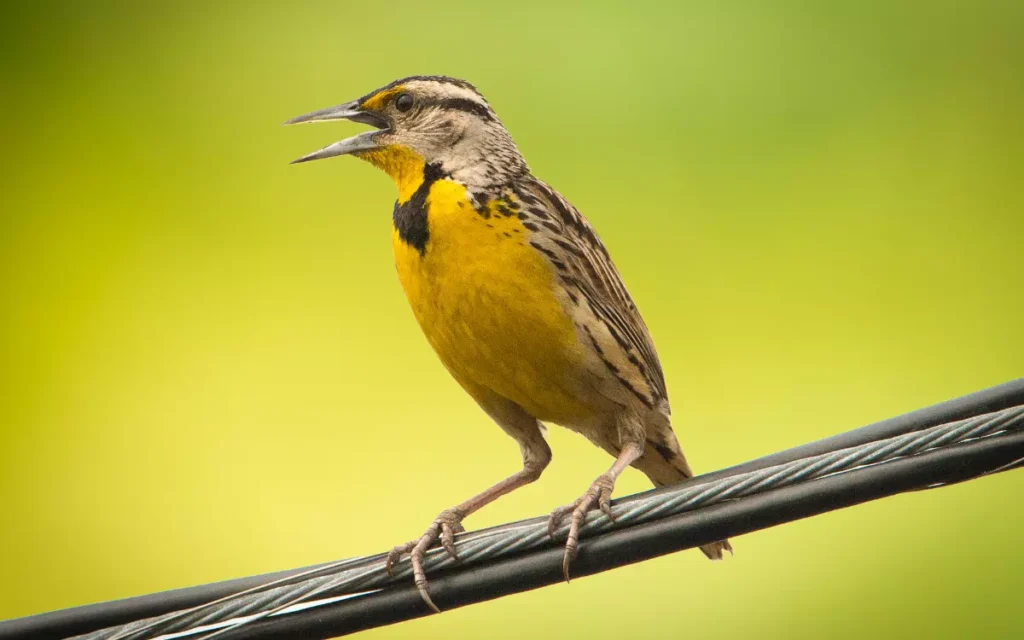
The Eastern Meadowlark is a notable bird, especially recognized for its sweet, lazy whistles that resonate over summer grasslands and farms in eastern North America. These birds are visually striking with their bright yellow underparts and a distinctive black chevron across the chest.
- Size: Eastern Meadowlarks are about 8-10 inches long, making them medium-sized birds with a chunky build, long thin bills, short tails, and long legs.
- Nesting: They build their nests on the ground in grassy fields or meadows. The nest is well hidden and constructed of grass and stems, sometimes with a dome-like structure.
- Habitat: These birds are commonly found in native grasslands, pastures, hayfields, agricultural fields, and along roadsides. They prefer open country throughout their range and can breed and establish territories in various open habitats.
To attract Eastern Meadowlarks to your backyard, maintaining areas with sufficient grass cover is key, as they prefer grassy fields for nesting.
Providing perching areas, open spaces, and grass seeds can create an ideal habitat for them. During the breeding season, they mostly eat insects, so having a healthy insect population in your yard can also be beneficial.
In winter, they may forage in flocks in fields for leftover seeds and grains, so ensuring the availability of these food sources can attract them.
13. Yellow-headed Blackbird
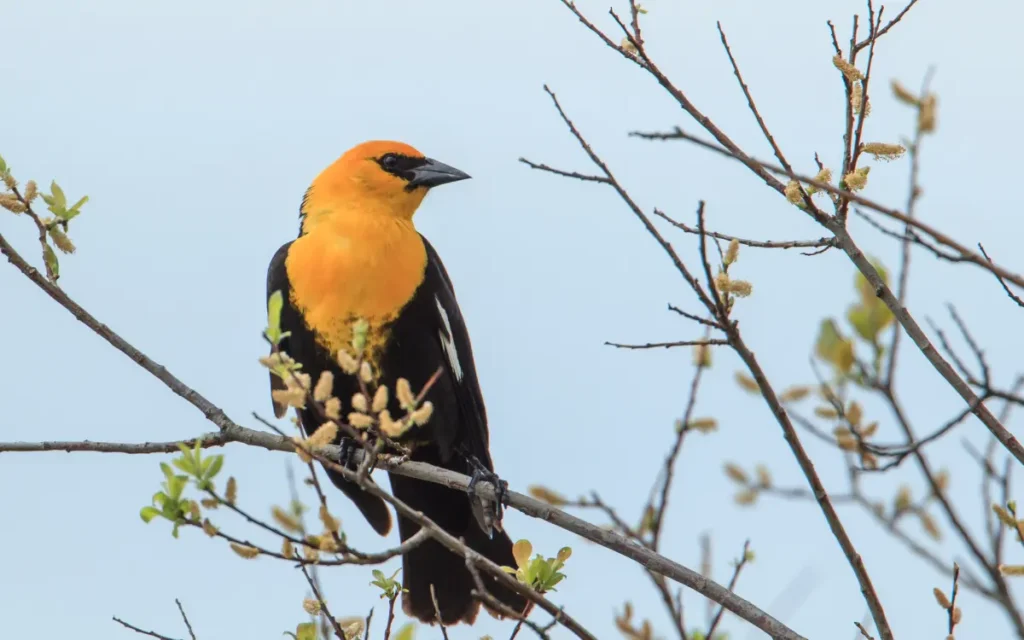
The Yellow-headed Blackbird is a striking bird known for its bright yellow head and chest, contrasting with its black body and white wing patches.
This bird is native to North America and is particularly visible in western and prairie wetlands. It’s known for its unique, raspy songs and buzzing calls, which are often heard in its natural habitat.
- Size: The Yellow-headed Blackbird is a medium-sized bird, typically measuring around 8.5 to 10 inches in length, with a wingspan ranging from 12.6 to 15.7 inches.
- Nesting: These birds nest in wetlands, often in reeds directly over the water. Females create nests of wet vegetation that hang over the water among reeds, bulrushes, and cattails. The nests shrink and tighten as the vegetation dries, and they lay three to five eggs per season.
- Habitat: Yellow-headed Blackbirds can be found from the Mississippi River westward, spending summers in the west-central United States and Canada, and winters in the western U.S. down to Mexico and Central America. They are often seen in freshwater wetlands, as well as in farm fields during winter.
To attract Yellow-headed Blackbirds to your backyard, offering seeds and grains, including sunflower seeds, can be effective.
These birds may visit feeders to eat these food items. Creating a habitat similar to wetlands or having nearby water sources might also encourage their visit, although they are more commonly found in their natural wetland habitats.
14. Bobolink
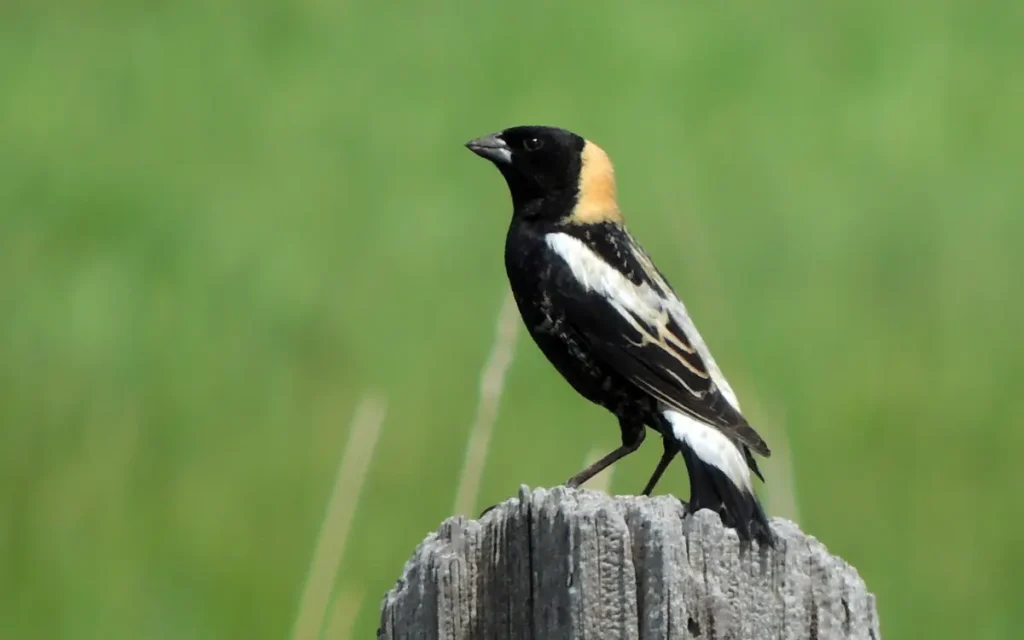
The Bobolink (Dolichonyx oryzivorus) is a small blackbird known for its striking plumage and distinctive song. Males during the breeding season are particularly notable with their black-and-white coloring and buffy nape, while females and non-breeding males have a more subdued brownish appearance.
Size: Bobolinks are relatively small birds, typically measuring around 7 inches in length with a wingspan of about 10.5 inches.
Nesting: They usually nest on the ground in open grassy areas, often in hayfields or prairies. Their nests are well-concealed cups made of grass, lined with finer grasses.
Habitat: Bobolinks are migratory birds, breeding across North America, particularly in the northern United States and Canada, and wintering in South America. They prefer open grasslands and are often seen in meadows, fields, and prairies.
Attracting Bobolinks to Your Backyard: Attracting Bobolinks specifically can be challenging as they are grassland birds.
However, maintaining a natural, undisturbed grassy area in your yard might appeal to them.
Avoiding pesticides, providing natural food sources, and ensuring a quiet, safe habitat can make your backyard more inviting to bobolinks and other bird species.
15. Orchard Oriole
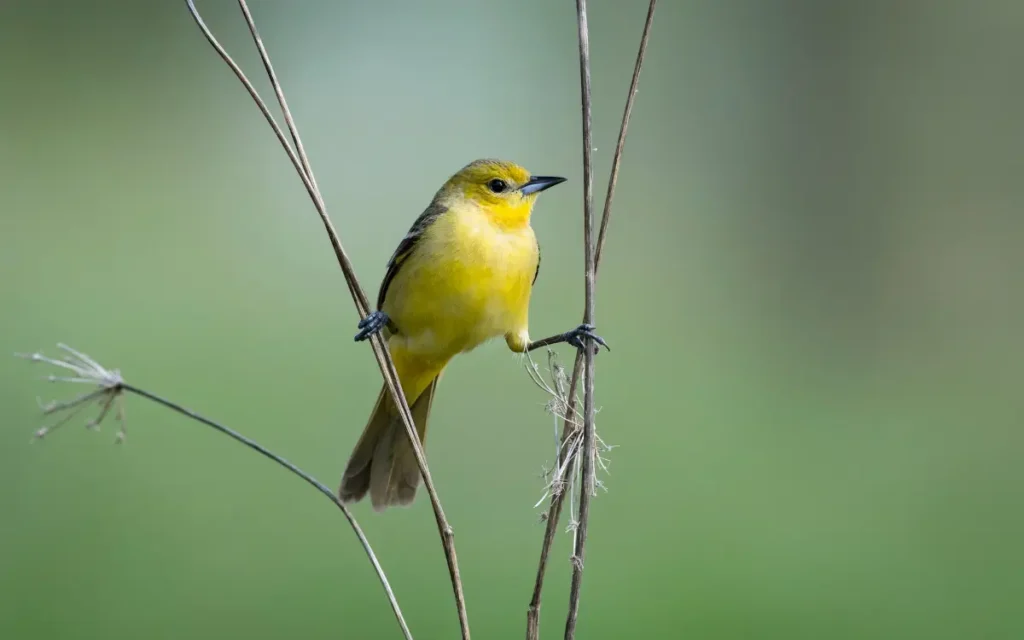
The Orchard Oriole (Icterus spurius) is a small, slim oriole known for its distinctive appearance and sweet song.
Adult males showcase a striking combination of black and chestnut-brown plumage, while females and juveniles are primarily yellow-green with white wing bars.
Size: Orchard Orioles are relatively small, measuring about 6 to 7 inches in length with a wingspan of approximately 10 inches. They weigh around 1 ounce, making them one of the more petite members of the Oriole family.
Nesting: These birds build their nests in semi-open habitats with deciduous trees, such as orchards, gardens, suburban areas, and open woodland parks. The females skillfully weave hanging nests from grass and plant fibers, often over water or in dense foliage, where they typically lay 3 to 5 eggs.
Habitat: During the breeding season, Orchard Orioles are found across the eastern United States, extending into southern Canada. They prefer areas like woodlands, river edges, and orchards. In winter, they migrate to Central America and the northern regions of South America.
To attract Orchard Orioles to your backyard, you might consider using nectar feeders or offering fruits and jelly.
These birds are less likely to be attracted to traditional seed feeders but are drawn to environments that replicate their natural habitat, especially those near a water source.
16. Common Grackle
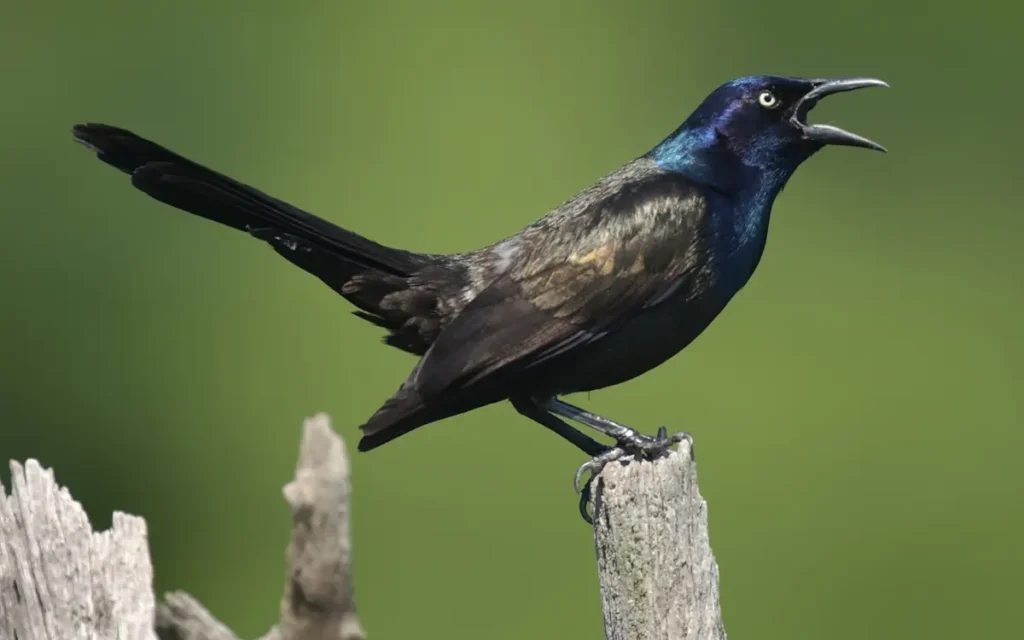
The Common Grackle (Quiscalus quiscula) is a distinctive New World blackbird, easily recognized by its glossy purple head and bronze sheen body.
These birds are quite social and known for their loud, clucking, and chattering noises.
Size: Adult Common Grackles measure 11 to 13 inches in length, with a wingspan ranging from 14 to 18 inches, and weigh between 2.6 to 5 ounces. They feature long bills, long tails, bright golden eyes, and flat heads.
Nesting: Common Grackles often nest in small colonies, choosing locations in dense trees near open areas. They are known to nest in places like groves, woodland edges, and parks. Occasionally, they nest in unusual places like old woodpecker holes, barns, or even in still-occupied nests of larger birds like Ospreys.
Habitat: These birds are prevalent in a range of habitats, from open woodlands near swamps and marshes to human environments like farmlands, parks, and urban residential areas. They are found throughout North America east of the Rocky Mountains, being permanent residents in much of their range, with northern birds migrating to the Southeastern United States.
Attracting to Backyard: To attract Common Grackles to your backyard, consider offering a variety of mixed grains and seeds.
Large hopper, platform, and ground feeders are effective, as they prefer to feed on the ground.
However, be mindful that excessive grain on the ground can attract rodents. Grackles also have a particular fondness for corn and sunflower seeds.
Common Grackles have an omnivorous diet, feeding on insects, minnows, frogs, eggs, berries, seeds, grain, and occasionally small birds and mice.
They are known for their resourcefulness in foraging, often seen following plows to catch invertebrates and mice, wading into water for small fish, and even stealing food from other birds.
Conclusion:
The Common Grackle is a fascinating and adaptable bird species, known for its distinct appearance and social behavior.
For bird enthusiasts interested in learning more about bird species in specific regions, such as South Carolina, exploring articles on local birds like the South Carolina hawk can provide insightful information about the diverse avian life in different habitats.

